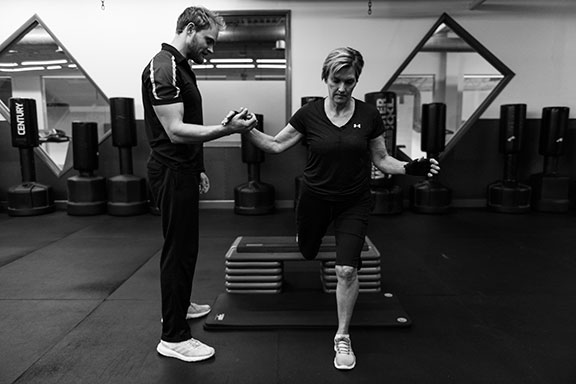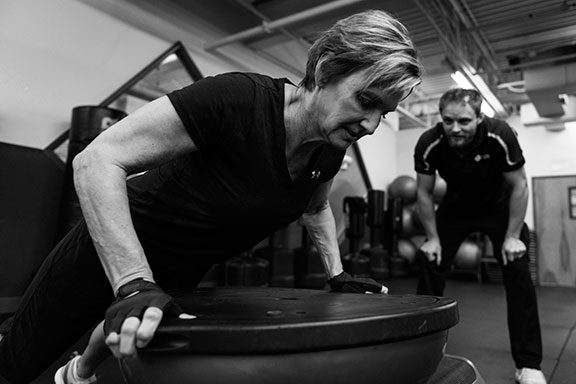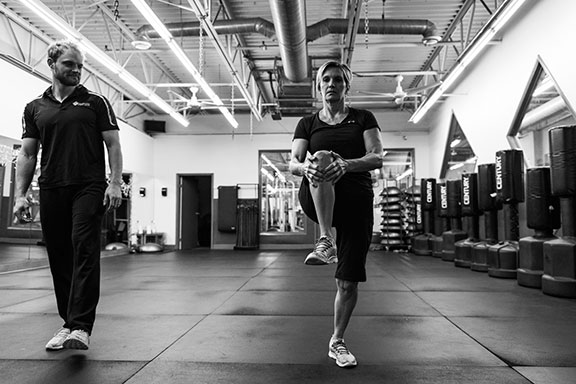Persevering with Parkinson’s
I was standing at the trainer’s station with personal trainer Dan Gaglianese when 64-year-old Karen Cretaro, came walking out of the locker room.
She looked as good as I remembered; sculpted arms, toned legs, a warm smile, and skin that had a natural radiance. A picture of health and fitness. Karen was no stranger to rigorous workouts. She had been a member at Champions Fitness Center for over twenty years and in her early forties taught both low-impact aerobics and step class. As she approached us, I wondered, did she feel as good as she looked?

Champions Fitness Center’s personal trainer Dan Gaglianese designs Karen Cretaro’s workouts to address the symptoms associated with Parkinson’s disease.
This year, more than 50,000 people worldwide will hear four life-changing words: “You have Parkinson’s disease.” Parkinson’s disease (PD) is a progressive and chronic, degenerative neurological disorder that affects one in 100 people over age 60. Symptoms can be so subtle in the early stages that they go unnoticed, leaving the disease undiagnosed for years. It is challenging to live with, as it causes progressive changes to motor function as well as many other non-motor symptoms, including depression, sleep problems, pain and cognitive dysfunction.
There were many times when Karen recalls feeling off. At her training sessions, she would tell Dan that she felt “funny.” Sometimes when she stood up should would feel lightheaded and dizzy. Symptomatic neurogenic orthostatic hypotension —when a person’s blood pressure drops suddenly after standing up— is quite common in those with Parkinson’s disease, affecting 15 to 50 percent of people.
She had been working on exercises for some of the hip issues she had, but now her neck muscles were stiff, her posture stooped, and her walk could be best described as; peculiar. So, in January of 2015 Karen and Dan made a “New Year’s Resolution” to address some of the physical struggles she was presented with.
Cretaro first noticed her Parkinson’s symptoms in September of 2015. She and her husband, Mike Cretaro, had owned an auto body shop in North Syracuse for more than 30 years. After hanging up the phone, she looked down to read some of the notes she had written. The handwriting was cramped, the words crowded together and the letter sizes unusually small. It was illegible.
“I was always looking for signs in my husband, cramped handwriting being one of them,” Cretaro said. His father had suffered from Parkinson’s. I remember thinking, “Am I so worried about my husband getting Parkinson’s, that I’m talking myself into it?”
In the early stages of Parkinson’s some people experience “freezing” a sudden, but temporary inability to start movement or to continue rhythmic, repeated movements. On one occasion Karen found herself frozen – unable to move in the middle of a step class. There was another incident where she struggled to do a set of jumping jacks. In her head she was jumping into the air, spreading her legs shoulder-width apart and swinging her arms out over her head, but her body just wouldn’t move. How stupid she thought. This was something she had done for years.

Karen Cretaro is no stranger to rigorous workouts She meets with a personal trainer once a week and attends group fitness classes and Rock Steady Boxing regularly.
As more symptoms began to appear, she searched for answers. “I would find articles online that would say, ‘10 common symptoms of Parkinson’s,’ and I remember going through one checklist and it said if you have experienced four or five of these symptoms you should see a neurologist,” Cretaro said. “I had checked seven of them.”
Karen told me about a trip she and Mike took up to Alexandria Bay. They took in the sights and planned on having dinner at a local restaurant that evening. As they walked her legs began to feel heavy, tired and weak. Mike offered to get the car, but the thought of not being able to walk 3 blocks seemed preposterous. She was so fatigued by the time they got back, she had to hold onto Mike’s arm to keep going.
When she got together with her closest friends, they would laugh and poke fun at one another about getting old. Unaware of what was going on they would say, “Karen, what the hell is wrong with you,” or “why are you moving so slow?”
She went to specialists for her hoarse voice and scheduled appointments to talk about her gait imbalance. At one appointment Cretaro’s doctor asked if she had trouble swallowing. She thought to herself, now why would he ask me that? Not long afterwards, she was sitting down for dinner with her husband and nearly choked on a mouthful of food. Fearing that she may throw up, Karen quickly excused herself from the table. For almost a year, she had been trying to hide her symptoms from her family, friends and customers.
In the fall of 2016, after much persuasion from her two daughters and several conversations with her primary care doctor (about the importance of going), Karen made an appointment to see a neurologist. After conducting several tests and ruling out everything else, Karen was diagnosed with Parkinson’s. It was hard to accept.
On the car ride home, she remembers thinking that this was something she could live with. It wasn’t a brain tumor or stage four cancer (which she had just lost a dear friend to). This was something she could manage.
Karen’s daughter, Julie Lombardi, works at Upstate Medical University and has worked with people with Parkinson’s disease for over 10 years. Looking back, she remembers her mother calling her to ask about a foot cramp. Julie told her to work on her posture. It wasn’t until the foot cramp progressed into abnormal movement of the foot and her arms started swinging less when she walked that she started to take a closer look. As more symptoms began to appear everything started to add up. At first, she struggled to understand how, after years of working with Parkinson’s patients, she missed the disease she knew so well in her own mother. She says. “It’s definitely been an ironic turn of events to have her get this disease.”

Although Parkinson’s disease can’t be cured, taking an active role in treatment, including adhering to a medication schedule and making healthy lifestyle choices, can provide a sense of control and help people with the disease live their lives to the fullest.
Every six months, Cretaro completes the Parkinson’s disease diagnostics test in Rochester. These tests are used to determine if the disease has progressed. The exam includes various movement and reaction tests. Karen also sees a speech therapist. The muscle impairment caused by Parkinson’s disease can affect how a person speaks. Cretaro noticed that when she spoke, the people around her table would lean forward. They weren’t hanging on her every word, they were having trouble hearing her. Her speech therapist will record her talking and play it back. Even though Karen feels like she is yelling, she can hear that she’s barely projecting her voice.
In Conclusion:
Although Parkinson’s disease can’t be cured, taking an active role in treatment, including adhering to a medication schedule and making healthy lifestyle choices, can provide a sense of control and help people with the disease live their lives to the fullest.
Cretaro says, “I think sometimes really bad things happens to really good people. There’s no reason for it, it just happens.” Karen’s optimistic outlook is both admirable and an inspiration to other’s who are afflicted with this disease.
So, what would Karen say to someone who suffers from Parkinsons? She would say, “stay strong, fight back and never lose hope.” Sometimes hope is all you need to persevere.
I have been a personal trainer for over seventeen years and I absolutely love what I do. I honestly feel that I have one of the best jobs out there! The most rewarding part of my profession is helping one of my clients succeed at reaching their personal fitness goals. I am currently certified by the National Sports Conditioning Association, Apex Fitness Group, and the International Sports Science Association.
PHOTOS BY BRYAN CEREIJO











